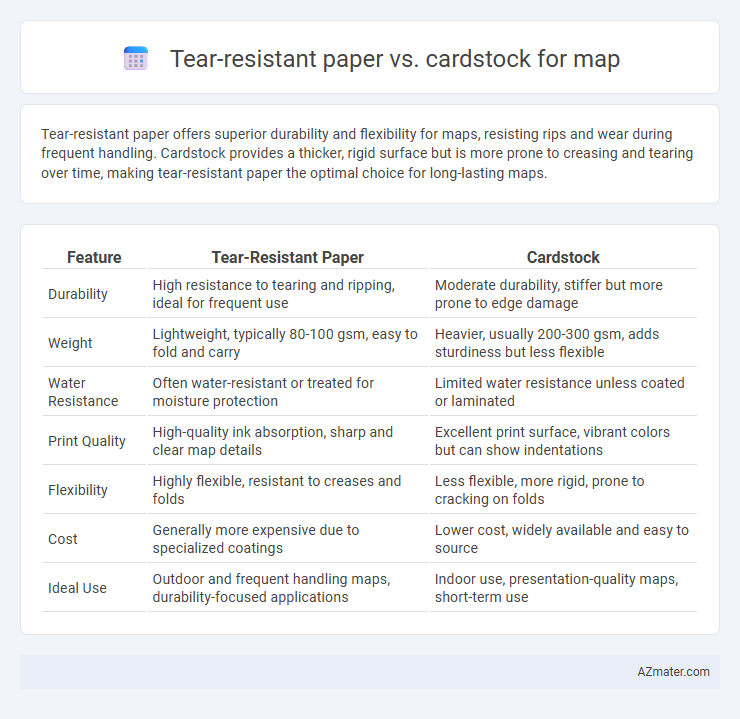Tear-resistant paper offers superior durability and flexibility for maps, resisting rips and wear during frequent handling. Cardstock provides a thicker, rigid surface but is more prone to creasing and tearing over time, making tear-resistant paper the optimal choice for long-lasting maps.
Table of Comparison
| Feature | Tear-Resistant Paper | Cardstock |
|---|---|---|
| Durability | High resistance to tearing and ripping, ideal for frequent use | Moderate durability, stiffer but more prone to edge damage |
| Weight | Lightweight, typically 80-100 gsm, easy to fold and carry | Heavier, usually 200-300 gsm, adds sturdiness but less flexible |
| Water Resistance | Often water-resistant or treated for moisture protection | Limited water resistance unless coated or laminated |
| Print Quality | High-quality ink absorption, sharp and clear map details | Excellent print surface, vibrant colors but can show indentations |
| Flexibility | Highly flexible, resistant to creases and folds | Less flexible, more rigid, prone to cracking on folds |
| Cost | Generally more expensive due to specialized coatings | Lower cost, widely available and easy to source |
| Ideal Use | Outdoor and frequent handling maps, durability-focused applications | Indoor use, presentation-quality maps, short-term use |
Introduction to Map Printing Materials
Tear-resistant paper offers enhanced durability and flexibility, making it suitable for frequently handled maps exposed to rough conditions. Cardstock provides a thicker, sturdier surface that supports detailed printing and resists creasing, ideal for maps requiring a premium feel and longevity. Choosing between tear-resistant paper and cardstock depends on the balance between durability needs and the desired tactile quality for map printing applications.
What is Tear-Resistant Paper?
Tear-resistant paper is specifically engineered with synthetic fibers or special coatings to enhance durability and resist ripping, making it ideal for frequently handled maps in rugged environments. Unlike traditional cardstock, which is thicker and stiffer but prone to damage from repeated folding and tearing, tear-resistant paper maintains flexibility and strength even under stress. This blend of toughness and pliability ensures maps printed on tear-resistant paper remain intact outdoors, withstand water exposure, and endure heavy use without compromising readability.
Understanding Cardstock: Features and Uses
Cardstock offers greater thickness and rigidity compared to tear-resistant paper, making it ideal for durable maps that require stability and frequent handling. Its high-density fibers provide excellent print quality with vibrant colors and sharp detail, enhancing the visual appeal of maps. Commonly used for professional presentations, marketing materials, and custom maps, cardstock ensures longevity and resistance to creasing, although it may lack the water and tear resistance found in specialized tear-resistant papers.
Durability: Tear-Resistant Paper vs Cardstock
Tear-resistant paper offers superior durability for maps by resisting rips and tears under frequent handling and harsh conditions, making it ideal for outdoor or heavy-use environments. Cardstock provides a thicker, sturdier base with rigidity that prevents bending but may be more prone to edge damage over time compared to specialized tear-resistant materials. Choosing between tear-resistant paper and cardstock depends on balancing flexibility and robustness to ensure the map withstands intended usage scenarios effectively.
Weight and Thickness Comparison
Tear-resistant paper for maps typically weighs between 70 to 100 gsm and has a thickness around 0.1 to 0.15 mm, providing flexibility and durability without excessive bulk. Cardstock used for maps generally ranges from 200 to 300 gsm with thicknesses of 0.3 to 0.5 mm, offering enhanced stiffness and longevity at the cost of increased weight. Choosing between tear-resistant paper and cardstock depends on the balance required between portability and robustness for map usage.
Print Quality and Color Vibrancy
Tear-resistant paper offers exceptional durability while maintaining high print quality, making it ideal for maps that require frequent handling without compromising detail clarity. Cardstock provides a sturdier base with vibrant color retention, ensuring that map colors remain bright and visually appealing over time. For vibrant, long-lasting prints, cardstock excels in color saturation, whereas tear-resistant paper balances toughness with detailed, sharp image reproduction.
Weather and Water Resistance
Tear-resistant paper offers enhanced durability against physical damage while maintaining flexibility, making it suitable for maps exposed to frequent handling. Cardstock provides superior thickness and rigidity, which helps resist wear but can be more prone to water damage unless coated. For weather and water resistance, tear-resistant paper often incorporates waterproof coatings or synthetic fibers, ensuring maps remain legible and intact in wet conditions compared to uncoated cardstock.
Cost Analysis: Tear-Resistant Paper vs Cardstock
Tear-resistant paper generally costs more than standard cardstock due to its reinforced fibers and durability-enhancing additives, making it a pricier option for map production. Cardstock offers a more budget-friendly alternative with moderate thickness and sturdiness, suitable for short-term or low-budget maps. When factoring in longevity and frequent use, tear-resistant paper may provide better value despite higher initial costs, reducing the need for replacements.
Best Use Cases for Maps
Tear-resistant paper is ideal for maps used in rugged outdoor environments where durability and water resistance are crucial, such as hiking and field research. Cardstock offers a thicker, more rigid option perfect for desk maps or presentations requiring a sturdy, flat surface. Choosing between tear-resistant paper and cardstock depends on whether flexibility and weatherproofing or structural stability and presentation quality are more important for the map's intended use.
Final Recommendation for Map Makers
Tear-resistant paper offers lightweight durability and flexibility, ideal for maps requiring frequent folding and outdoor use, while cardstock provides superior rigidity and a premium feel suitable for display maps or presentations. Map makers should prioritize tear-resistant paper for practical, long-lasting field use, ensuring resistance to wear and environmental factors. For projects emphasizing aesthetic appeal and durability without extensive handling, cardstock remains the recommended choice.

Infographic: Tear-resistant paper vs Cardstock for Map
 azmater.com
azmater.com